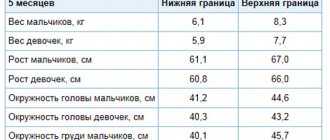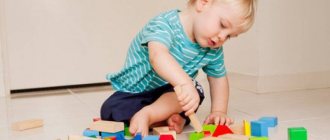A child in the 5th month continues to master the tools of communication: smiling, laughter, babbling, which become more expressive, lively, and filled with meaning every day. He becomes more active and mobile in movement: he turns over, gradually strives from a lying position to a sitting position, and independently takes on various poses. The development of a child at 5 months is a period of consolidation and improvement of previously acquired skills and a transition to a new way of life, when the baby can already sit.
Physiology of a baby in the fifth month
The physical development of a child at 5 months moves to a new stage. During this period, the baby grows up and does not gain weight as quickly as before. The growth parameters of a five-month-old baby vary from 64 to 68 cm. This means that the increase in height is about 15 cm from the moment of birth. The weight by this time approximately doubles and is now in the range from 6 to 8 kg. During this month, he will grow by an average of 2 cm and gain 0.7 kg.
Sometimes at 5 months a child manages to get ahead of development: weight and height may exceed general norms. Moreover, according to statistical data, boys usually weigh 0.6 kg more than girls, and their height differs from the height of girls by 2 cm. The child spends more time not in a state of sleep, but actively awake during the day.
New skills and abilities for the 5th month
Some five-month-old babies can already roll over from their stomach to their back and vice versa. As soon as they master and consolidate this skill, the idea comes to them not to stop there. Attempts to move the arms and legs continue: on the bellies, in a lying position, without lifting the tummy from the surface. Such gestures are more reminiscent of swimming and warn that the baby should soon crawl. At this moment, you should be especially careful and not leave the child on an open surface, even at a small height, because a fall from at least 30 cm can seriously injure him.
He is not yet able to sit without support, but the baby will feel comfortable in a semi-sitting position, for example, in a high chair or simply in pillows. This will be the best position for him to support his back. Moreover, he already so badly wants to try himself in the role of an adult that if you take him with your hands under his armpits in a vertical position, he will rest his straight legs on the floor, and even move them, imitating walking. If you take a baby in a lying position by the hands, he will pull himself up by them and hold his head, preventing it from throwing back. These movements are still reflexive, but the baby consolidates them in memory and repeats them later consciously.
What can a baby already do?
First, let's figure out what a child at this age should be able to do. But we remind you that children are individuals. They can be able to do different things at this age. However, there is something that they definitely need to learn to do. He already turns over on his own while lying down, and may even make his first attempts to crawl. The baby sits with support, but bends his back. Therefore, it is not recommended for him to sit for a long time. If you take your toddler by the arms and place him, for example, on the sofa, he will be able to keep his legs straight.
The child coordinates movements and can grab and hold things. Some toys can keep him occupied for up to 15 minutes. He recognizes his parents well and is afraid of strangers. His speech is developing very actively. He pronounces individual sounds and can even do this with intonation. Children at this age love music and rhymes that their mother tells. They can easily hold a bottle while being fed. Or adjust the chest to make it more comfortable for him. At this age, they demonstrate gymnastic skills: they can pull their legs up to their mouth and stick their fingers into it.
Motor coordination skills
Features of the development of a 5-month-old child include improving motor skills. At the age of 5 months, the baby is already able to clench his fists tightly, deftly grasp a rattle or his mother’s finger, holding it with both hands, bringing it closer to his face, and also transfer it from one hand to another. The desire to grow up is manifested in the ability to independently hold a bottle of water or formula, which gives great pleasure to the baby, following the approving gaze of his mother.
Lying on his stomach, the baby can rise up on his elbows and hold his head firmly. Thus, the norms for child development at 5 months are as follows:
- he really wants to stand on his feet, and with support he can hold out for several minutes in an upright position;
- he can remain in a semi-sitting position for a long time, he is able to sit down independently, pulling himself up with the help of his hands;
- can consciously grasp objects and hold them with both hands;
- quickly rolls onto its side, as well as from its stomach to its back and back;
- he makes melodious sounds for a long time and enjoys listening to them.
How to help your child develop
During this period, activities with the child must certainly be focused on the development of the musculoskeletal system. Particular attention should be paid to exercises for the back muscles, since the baby needs to learn to sit, as well as strengthen the skill of turning from back to tummy and back. It is necessary to conduct daily 20-30 minute exercises in combination with massage. It is recommended to accompany all exercises with counting, so the child develops a sense of rhythm. You can turn on rhythmic music.
Squat exercise with spine bending (do once a day):
- The child lies on his back. Place your thumbs in your baby's hands and let him squeeze them. Use your remaining fingers to grasp the child’s wrists;
- Spread the child's arms slightly to the sides and pull him towards you until the baby sits down;
- Then lift the baby’s arms up and secure them there with one hand;
- Use the fingers of your free hand to move along the baby’s spine from bottom to top. At the same time, the child will reflexively straighten his back;
- After this, carefully supporting the head, place the baby in its original position.
“Crawling”: lying on their tummy, babies are already trying to reach the toy lying nearby. This cannot be called crawling yet, but it can be considered the first step towards crawling. Place toys next to the baby at a distance slightly greater than the child's outstretched arm. Use your palm to create support for his legs. Let the baby try to crawl and grab objects. This will be good gymnastics for all muscle groups of the baby.
Massage for a 5 month old baby should be somewhat more complicated. In addition to rubbing, stroking, vibration and effleurage, you can use pinching, tong-like kneading and felting.
Continue to carry the baby in your arms. “Talk” to him, tell him and show him everything around him. Allow the baby to explore as many objects as possible, but be careful, because the child now puts everything in his mouth, so make sure the toys are clean and the surrounding objects are safe.
For a while, the baby can now be placed in the playpen, but do not leave him there for a long time. A long stay in a playpen or crib gives the baby the impression of isolation and limited space and can dull the child’s desire to explore the world.
Games
For a five-month-old baby, games of “Peek-a-boo”, “Magpie-Crow”, “The Horned Goat is Coming”, “Ladushki” will be interesting. (see 4 months). At this age, kids love games with different sounds:
- “As Animals Speak”: Make sounds by imitating animals. At the same time, name the animal and show it in the picture;
- Read books with nursery rhymes and quatrains to your child, they develop the child’s memory;
- Touch different parts of the child’s body, affectionately calling them: snub nose, little blue eyes, rosy cheeks;
- Sew small bells to the baby's socks, let them ring when the baby moves his legs. You can make bracelets for the hands with bells or bright stripes (butterfly, flower), the baby will look at them when he raises his hands;
- Roll call: gradually introduce new syllables into the baby’s “vocabulary”. Listen carefully to what the child is “saying”, and then respond to him as if you are holding a conversation. After some time, the baby will repeat after you. It is important that the baby sees your face, watches your gestures and facial expressions.
Play with your baby in front of the mirror. Take the child in your arms and wave your hand to the reflection in the mirror. Perhaps the baby will be very surprised by the appearance of the second mother with someone in her arms. While the child perceives the reflection in the mirror as another living object. If you take a toy in your hand, your baby will try to grab it in the mirror without noticing it in your hands. Until about 1.5 years old, children do not understand that there is only a reflection in the mirror.
To develop tactile sensitivity, make a set of multi-colored pads from different fabrics (flannel, silk, corduroy). When the baby is lying on his tummy, give them to him, let him touch and look at them. When the child grows up, these pillows can be arranged in pairs according to color, size or pattern.
If you like to sew, you can make a textile book especially for your baby with appliqués from different fabrics, Velcro, lacing, and sewn buttons. The subject of the book may vary depending on the gender of the child.
Improving manual dexterity
The baby develops and improves the ability to lift his head and shoulders while lying on his tummy. The fulcrum moves from his elbows to his hands, and the time he is able to hold in this position increases from 1 minute to 5 minutes, especially since from this position it is much more interesting for him to look at the world around him.
The regulation of movements also reaches a new level. Hand gestures are now coordinated with the help of vision: the child can accurately reach the object of interest to him, regardless of direction and distance.
The development of a child at the 5th month of life allows you to feel a change in fine motor skills of the hands: the baby holds an object for a long time, takes it from adults, transfers it from one hand to another, presses buttons. Mom's help in mastering new movements consists of massaging her palms, training with bending and straightening her fingers, and playing together with rattles and other bright, interesting objects.
The child begins to be interested in his own body, which manifests itself in feeling his limbs. From the outside it looks funny, but it’s normal for their age, you shouldn’t try to stop the child, on the contrary, you need to comment on what these body parts are called.
How long does a 5 month old baby sleep?
A 5-month-old child has already grown up, his development and routine are changing. A healthy 5 month old baby, if well fed and not bothered by anything, can sleep for 10 hours at night without waking up for a night feed. To achieve this result, the mother tries to provide rationally organized daytime rest for her baby. To do this, she should divide her daytime sleep into three 2-hour intervals.
The child is put to bed for the first time after 2 hours of morning wakefulness. It is best to spend this time on a walk, because it is in the morning that sleeping in the fresh air, especially in favorable weather, will benefit the baby. The second time the baby is put to bed after lunch, and again this can be combined with a walk, especially in the warm season. The third time occurs in the evening.
Modern pediatricians recommend adhering to just such a sleep schedule for a five-month-old baby, considering it reasonable. Provided that the baby fell asleep too deeply and slept for more than 2 hours, he must be carefully woken up so as not to disrupt the established daily routine. The same should be done if he woke up earlier than 2 hours later: put him to bed at his usual time.
Sleep and wakefulness patterns depend on the nature and living conditions. Sometimes babies can even confuse day with night, but if you organize the routine correctly, it will be easier for the mother to cope with raising the child.
Caring for a five month old baby
A 5 month old baby needs the same care as before. After waking up, you need to wash him, wipe his eyes, clean his nose and ears if they are dirty. Several times a week, the baby needs to trim his nails with special scissors. It is better to do this after bathing, when the nail plates have softened a little.
You need to bathe your child at least every other day. But if you have a desire, and the baby loves this process, then you can do it more often. You can use various slides, mattresses and hats. If the baby sits on his own, then get a special bathing seat. This will make the process much more fun. You can take various toys with you, and your little one will be happy to play with them.
Remember that the water should be the same as the person's body temperature. And if your baby has problems sleeping, then add herbs to it. It could be chamomile, lavender or string. They will calm the little one and it will be easier for him to fall asleep. In addition, do not forget about gymnastics and massage. This is very important, because very soon the baby will begin to walk, and he needs strong muscles.
Nutrition at 5 months
During this period, changes occur in the baby’s daily routine, so it is recommended to switch it from feeding six times a day to five times a day, keeping intervals between them of 4 hours during the day. The nutritional norm is already about a liter of milk per day. The baby does not doze off while eating, but actively satiates.
Now he no longer needs his mother's breast to lull him to sleep. This is a good time to wean him from the habit of falling asleep while suckling, so it is recommended to start naps with rocking rather than feeding. Just before going to bed at night you need to feed the child properly. For him, this will not only provide him with food, but also an opportunity to calm down, as a result the baby will sleep soundly at night.
Five-month-old babies who receive breast milk do not yet require complementary feeding; they have enough of the beneficial substances that they receive from their mother’s milk. If the baby does not have enough mother's milk and is capricious and does not gain weight well, he should be switched to mixed feeding, first using dairy-free cereals, and after some time, dairy ones. Porridges can be rice, buckwheat, or corn. Complementary foods were introduced into the diet of formula-fed children already at four months of age.
Until the age of 5 months, the baby ate only liquid food. But at five months, the baby can eat homogenized, thin baby puree, and most mothers are already starting to add it to the child’s diet, although pediatricians advise waiting until the next month to introduce complementary foods.
You need to introduce new products to your child’s menu one at a time and carefully, be sure to watch his stool and skin. If a rash appears or the color of the stool changes, then the new diet must be discontinued.
The diet has not changed. At five months of age, it is permissible to introduce complementary foods in cases where:
- Mom doesn't have enough milk;
- the baby is crying and not gaining enough weight;
- his stomach bothers him;
- It doesn't stain the diaper much.
In such cases, you should consult a pediatrician. He must determine the diagnosis and advise the necessary complementary foods.
Height and weight indicators
It is very easy to calculate the normal weight for a child at five months: it is enough to double his weight at birth. On average, this figure will be around seven kilograms. By the end of the fifth month, he will approach eight kilograms. The baby's height will reach 65-70 centimeters. Height and weight indicators may vary depending on development conditions and hereditary characteristics. Small deviations may disappear over time, but if there are significant differences in indicators from the average age, you should start to worry.
Mental and mental development
A five-month-old child is already well aware of his close circle, which is trustworthy; he perfectly distinguishes his friends from strangers, towards whom he begins to show distrust, so he will not agree to go into the arms of anyone who calls him.
The baby is excellent at distinguishing the intonation of speaking people. A gentle tone makes him smile, but an angry voice can make him cry. If earlier he could divide all his feelings only into comfort and discomfort, now many new shades arise: excitement, pleasure, fear, sadness, anxiety.
By chatting, a baby can express various requests. He knows how to demonstrate displeasure if something does not suit him. His irritated cry will express protest when the rattle that interests him is taken away from him or put in his crib, and he still wants to bliss himself in his mother’s arms.
The big world around us opens up for the baby, and he tries to explore all the objects not only visually, but also by touch, and at the same time by taste. When for some reason the baby ceases to be interested in a toy, he may drop it and forget about it. Just a month ago, any thing that fell into the hands of a baby was first put in the mouth and examined for taste, and then examined in detail. But now the first thing the child does is twirl it, look at it from all sides, even shake it, and only then put it in his mouth.
The baby's hearing during this period is so subtle that he turns his head in an attempt to discover the original source of even the quietest rustle. Almost all kids love rhythmic music and become more active when they hear a lively, cheerful melody.
Common problems
A five-month-old baby is a big fidget. Therefore, it can suddenly turn over and hit. You need to watch him very carefully and not leave him alone. Children at this age begin to cut their teeth, so they can be capricious, cry and even scream. The first complementary foods can change the condition of the baby's stool. Quite often he may experience constipation. Then it is worth excluding new foods from the baby’s diet. You can try to enter them later. If you are breastfeeding and your baby gains less than half a kilogram in a month, then go to the doctor.
If the baby retains the reflexes of a newborn and has hypertonicity, then you should not delay a visit to a specialist.
Speech development
At the age of five months, the child tries to imitate the conversation of adults, in particular intonation. The formation and improvement of the baby’s speech continues, expanding the volume of pronounced vowels and consonants, entire syllables, experimenting with their combinations.
Such babble is sometimes formed by frequent, repeated reproductions of repeated syllables. These children's words do not yet have any meaning, but they are already making parents happy. The enthusiastic reaction of others will encourage the baby to again repeat the combinations of sounds with which he managed to attract the attention and approval of his parents. And sometimes he likes to talk to himself.
Games
In terms of communication, the baby is already beginning to interact dynamically with adults. He himself offers and willingly supports common play, for example, he can throw a toy so that his mother picks it up and returns it to him. The psychological significance of the game lies in the child’s subconscious reinforcement of the stability of his position in the world and in the family. This is a very significant factor: trust in others is formed, which helps harmonious personal development.
All children love the popular game of peek-a-boo, without which not a single baby has grown up, and which greatly influences the relationship between mother and baby. This is a significant proof of maternal love for him - his mother thinks about him and is looking for him. Kids like games that involve reproducing the sounds of different animals. For the all-round development of the baby, he will need several colorful toys, preferably with sound.
An intelligent and curious five-month-old baby has already grasped the meaning of words such as “no” and knows how to respond to the words “give”, “na”, “come to me”. The baby's delight is caused by motor games when he is thrown into the air, held under the armpits.
It is recommended to read books to children, show pictures, tell poems and nursery rhymes. It is advisable to continue acquainting the child with the names of various household items when examining the room with the baby in his arms, as well as with the physical properties of things, offering to touch them.
Gymnastics
During this period, all pediatricians advise not to forget about massage and gymnastics. It only takes a few minutes, but gives a very noticeable effect. The baby learns the basics of controlling his body. To learn to crawl, a baby needs space. The exercise consists of placing an adult palm under his heels so that he can push off from it and move forward.
Some parents teach their children to swim, which has a lot to do with the child’s health and accelerates its development. Systematic swimming training expands the lungs and improves coordination of movements. Trained children get on their feet faster and start running. For your child to enjoy swimming lessons, the procedure should be limited to 10 minutes, and the activity itself should turn into an entertaining game.
There are many sets of exercises for kids. All of them are aimed at developing the musculoskeletal system, most of all at strengthening the back muscles, because soon the baby will have to learn to sit. Such activities require 20 to 30 minutes daily. It is advisable to accompany them with rhythmic music or counting to develop a sense of rhythm.










